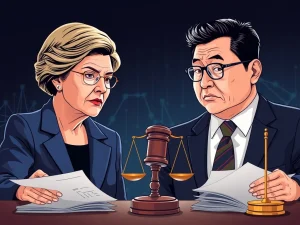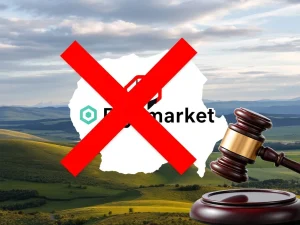Urgent Alert: Binance to Delist 14 Tokens in Major Purge

Heads up, crypto enthusiasts! Binance, one of the world’s leading cryptocurrency exchanges, has just dropped a bombshell announcement. Get ready for a significant shake-up as Binance is set to delist 14 tokens from its platform. This isn’t just a minor adjustment; it’s a full-scale purge aimed at weeding out projects that don’t meet Binance’s increasingly stringent standards. If you’re holding any of the affected altcoins, you need to pay close attention.
Why is Binance Initiating This Token Delisting?
Binance isn’t making these decisions lightly. The exchange has emphasized a “comprehensive evaluation” process behind this mass token delisting. This evaluation isn’t just based on internal metrics; it even incorporated community feedback through their first “vote to delist” initiative. Projects with less-than-impressive performance were nominated by the community itself, adding a layer of democratic accountability to the process. But what exactly were the criteria?
- Team Commitment and Development Activity: Is the project team actively working and innovating?
- Trading Volume and Liquidity: Are these tokens actively traded with sufficient liquidity?
- Network Stability: Is the underlying blockchain network reliable and stable?
- Responsiveness to Due Diligence: Is the project team cooperative and transparent when Binance requests information?
- Regulatory Compliance: Do the tokens and projects adhere to evolving regulatory requirements?
These factors, combined with the community vote, painted a clear picture for Binance, leading to the upcoming removal of these 14 tokens.
Which Altcoins are Facing the Binance Chopping Block?
Here’s the list of the 14 tokens slated for delisting from Binance on April 16th. If you hold any of these, take note:
- Badger (BADGER)
- Balancer (BAL)
- Beta Finance (BETA)
- Cream Finance (CREAM)
- Cortex (CTXF)
- Aaelf (ELF)
- Firo (FIRO)
- Kava Lend (HARD)
- NULS (NULS)
- Prosper (PROS)
- Status (SNT)
- TROY (TROY)
- UniLend (UFT)
- VIDT DAO (VIDT)
If you are holding any of these altcoins on Binance, it’s crucial to understand the next steps and consider your options before the delisting date.
Why is Binance Tightening its Crypto Exchange Listing Requirements Now?
This move by Binance is part of a broader trend within the crypto industry. Exchanges are facing increasing pressure to enhance investor protection and comply with evolving regulatory scrutiny. Binance itself has been proactive in this area. Earlier in 2024, they extended the “cliff period,” the lock-up time for newly listed tokens, to a minimum of one year. This measure aims to prevent quick “pump and dump” schemes and encourage more sustainable project development.
Binance isn’t alone in this. Other major crypto exchanges are also raising the bar for token listings. Bitget, for instance, revamped its listing process in October 2023, focusing on factors like fully diluted valuation and investor lock-up periods. South Korean exchanges are also tightening their rules due to new domestic regulations.
Is This Delisting a Sign of a Maturing Crypto Market?
Absolutely. The cryptocurrency market is evolving rapidly. In the early days, the focus was often on rapid growth and listing as many tokens as possible. However, the sheer explosion in the number of cryptocurrencies – with platforms tracking over 13 million and estimates going even higher – has created a crowded and sometimes diluted market.
Consider these statistics from crypto analyst Ali Martinez:
| Era | Number of Altcoins |
|---|---|
| 2013-2014 | Less than 500 |
| 2017-2018 (Altseason) | Fewer than 3,000 |
| Today | Over 36.4 Million |
This massive increase in altcoins might be contributing to why the anticipated “altseason” hasn’t fully materialized in the current cycle. A more discerning approach to token listings, like Binance’s, could be a positive step towards a healthier and more sustainable crypto ecosystem.
What Does This Mean for Crypto Investors?
For investors, Binance’s delisting action sends a clear message: quality and sustainability are becoming paramount. Here are key takeaways:
- Enhanced Investor Protection: Stricter listing standards ultimately aim to protect investors from potentially risky or underperforming projects.
- Focus on Quality Projects: Exchanges are prioritizing projects with strong fundamentals, active development, and regulatory compliance.
- Market Consolidation: Delistings can help to consolidate the market, focusing attention and investment on more robust and promising cryptocurrencies.
- Due Diligence is Crucial: Investors should always conduct thorough research before investing in any cryptocurrency, considering factors like team, technology, and market dynamics.
In Conclusion: A Necessary Purge for a Healthier Crypto Future?
Binance’s decision to delist 14 tokens is a significant move that reflects the maturing landscape of the cryptocurrency market. While delistings can be concerning for holders of affected tokens, this action signals a positive shift towards greater quality control and investor protection within the crypto exchange ecosystem. As regulatory scrutiny intensifies and the number of altcoins continues to grow, expect to see more exchanges adopting stricter listing criteria. This purge could very well be a necessary step in building a more robust and sustainable future for crypto.









